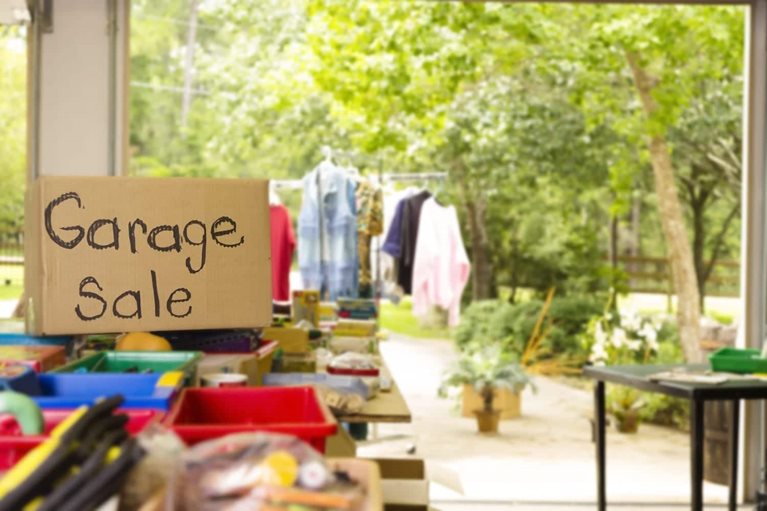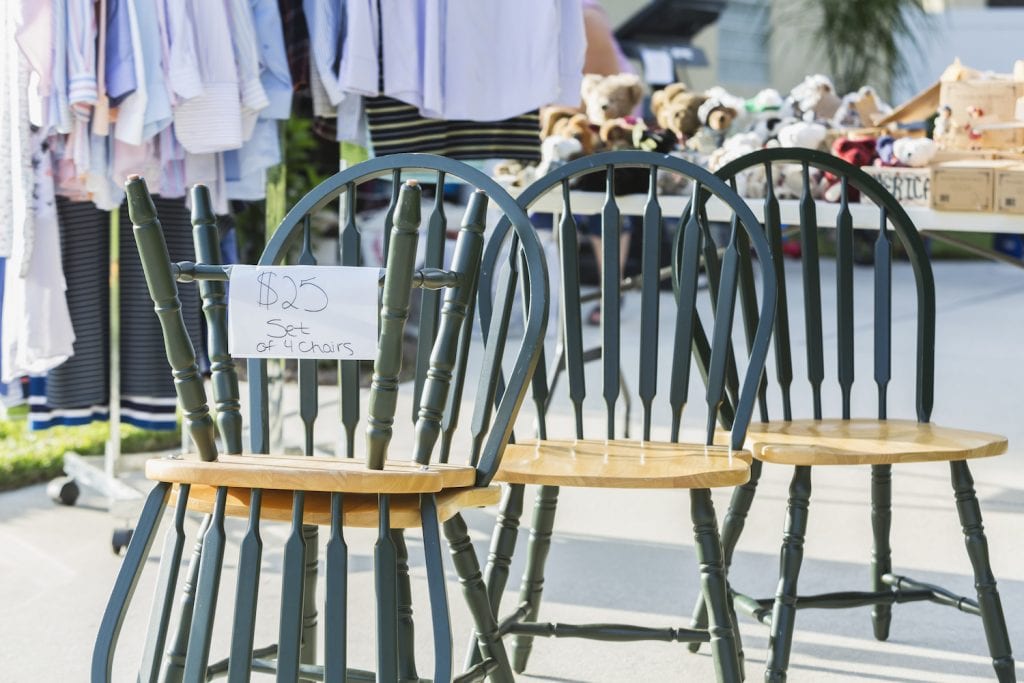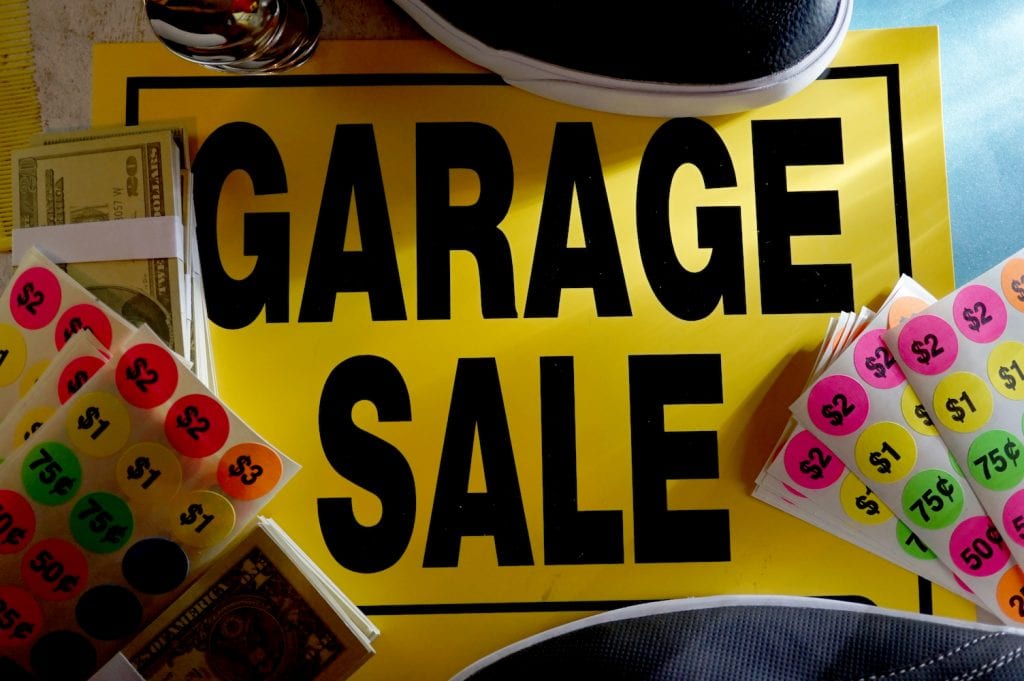
How to stage a successful garage sale before making your move
Moving is about opportunity. Whether you’re relocating to pursue a career path, start a family, experience a different place, or simplify your life by downsizing, new possibilities are on the horizon. Adding a garage sale to your moving checklist can give you additional opportunities to declutter, get organized, and earn a few extra dollars in the process. With just a little planning and preparation, you’ll find yourself with less stuff, more cash, and a much easier move.
Here are some smart tips to help you have a successful moving sale:
Set a Date for Your Moving Sale ASAP
Unlike your friends and neighbors who can have a garage sale any ol’ time, you’re on a schedule because of your move. Ideally, your moving sale should take place three to four weeks before you relocate so you have time to donate or find places for unsold goods, and finish packing.
In most areas, weekends are prime garage sale times. Having a multi-day sale or planning your sale at the same time as others in your neighborhood may increase foot traffic. Talk to your neighbors to see if they’re interested in teaming up, and check your local news sites or community message boards to see if others are already advertising sale dates.
Check Local Rules and Regulations for Garage Sales
Some cities and towns have laws that impact garage sales. These typically aren’t a hassle. It’s just best to know them in advance so you can plan accordingly. For example, there may be regulations regarding sign placement or fire safety for neighborhood gatherings, or you may need a temporary permit to sell things in a residential area. To find out, just call your city hall and ask about rules and regulations for garage sales in your neighborhood.
Identify and Gather Your Inventory
This is the tough part for most people -- determining what you don’t want, don’t need, don’t actually use, or won’t have room for at your new place. The best way to get through this is to be as methodical as possible. Grab a pen and paper (or your smartphone or tablet) and take it room by room. Consider furniture, appliances, kitchenware, decorations, clothes, toys, books, electronics -- everything. With each item, ask yourself: Do I use this? Do I need this? Do I really want this, or could I have something better (like more space) if I sold it? As you go through each room, set aside the things you are ready to part with. This will be your moving sale inventory.
If your move is part of a major downsizing, you may want to rent a portable moving and storage container to give you extra room for sorting and organizing. This can serve as a garage if your home doesn’t have one or a second workspace if you’ll need to comb through the contents of your existing garage. Once your moving sale is over, you can then use it to load the stuff you’ll be keeping and moving to your new place. And if there are things you’re not ready to part with, it can also serve as a temporary storage solution. For example, PODS will take your container to one of their secure storage facilities until you’ve decided where they need to go.

Name Your Prices
Once you have your inventory, it’s time to decide how much you want to ask for each item. Remember that people shopping at garage sales are looking for bargains. You likely won’t get top dollar for your goods, but that isn’t your main objective. Your goal is to minimize clutter, lighten your moving load, and earn a few extra dollars that can either go toward your moving expenses or new things and experiences once you’ve relocated.
With that in mind, here are some tips for setting the right prices:
- Try not to base your price on sentimental value. Your vinyl album collection may have gotten you through the toughest years in high school – a priceless service. However, your neighbor likely won’t have the same assessment.
- Research going rates. Doing a quick Internet search can give you a sense of what people are willing to pay for used goods. For example, children’s clothes tend to run $1 to $3 for items in good condition. Adult clothes are usually $3 to $5, but can be more if the item still has a price tag or serves a special purpose, such as a business suit, uniform, evening gown, or costume. Books and music can go from 50 cents to $2, depending on condition. Furniture may be $10-$20 for a cloth-covered chair or sofa to $75-$100 for a wooden piece or large item.
- Consider selling small-but-valuable things online. If you have collectibles, fine jewelry, or small electronics like classic iPods or video games, you may get better returns by selling them online through an auction site or classified listing. Consider the size and value of the item before going this route, since shipping costs for larger or low-value items may outweigh the benefits of an online sale.
- Bundle small, similar items. It may be easier to make and process the sale of smaller items if you package them together. Instead of selling one paperback book for 25 cents, consider bundling a box of 10 romance novels for $2. You might also do this with toys, CDs, DVDs, games, baby clothes, t-shirts, and more. Likewise, if you have sets that could sell in pieces, offering a bulk discount might help you sell them all. For example, if you have a five-piece tea set, and you’re willing to sell each piece for $5, consider offering the whole set for $15 to $20 to incentivize a larger purchase.
- Be open to negotiation. Many garage sale goers love to haggle. It’s part of the process (and fun!), and it can be part of your success if you’re ready for it. If you’re open to negotiating prices, you may mark your items a little higher to start, but don’t overdo it. In the last few hours of your sale, if you’re still hoping to offload more things, you may be the one to start negotiations!
Advertise Your Moving Sale
Posters, lawn signs, and classified ads in the local newspaper are classic garage sale advertising options. You should certainly consider those, but nowadays you can do so much more to get the word out online. In addition to traditional advertising, consider creating a Facebook or other social media event page. Promote the event in your social media posts, and ask your local friends to share it with their network. You could also spend $25 to $50 for a paid social media ad that targets people in your immediate area. Online message boards, digital classified ads, and community calendars are all great options for promoting your sale to a broader audience.

Gather Your Sale Supplies
You’ll need just a few inexpensive things to set up and run your moving sale: labels for marking prices; poster paper and markers for creating signs; tables and chairs; sheets or tablecloths on which to display your wares; boxes and bags for packaging sold goods; and drinks and snacks to keep yourself energized. You also want to make sure you have a secure cash box and enough cash on hand in small bills and coins to make change. If you’re planning to sell some items online, you may also want to stock up on envelopes, boxes, and shipping labels in advance.
By taking these steps, you’ll be well positioned to have a successful garage sale, helping you to declutter, destress, and earn extra cash before you move.
Now that you’ve got this garage sale thing down, you’re probably looking for other ways to make your move easier. You’ll find some valuable tips with 5 Moving Hacks the Pros Use and 9 Things to Consider Before Hiring Cross-Country Movers.
Jean Valerie Dale is a writer and photographer who has made a number of cross-country moves, living and working in the Golden State, the Sunshine State, and the Deep South.
Comments
Leave a Comment
Your email address will not be published. Required fields are marked *